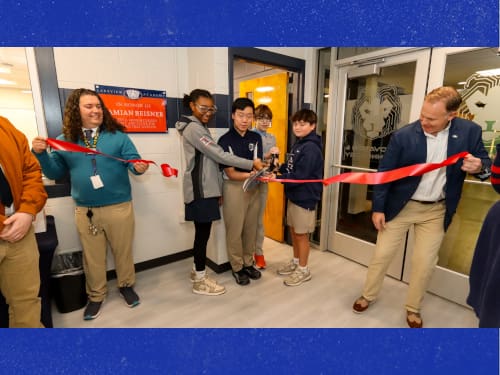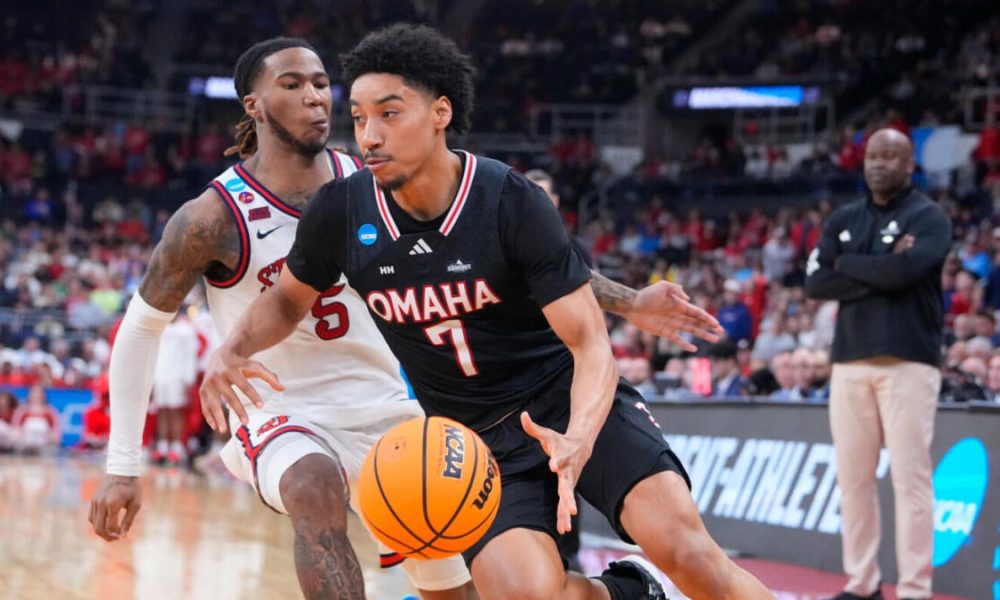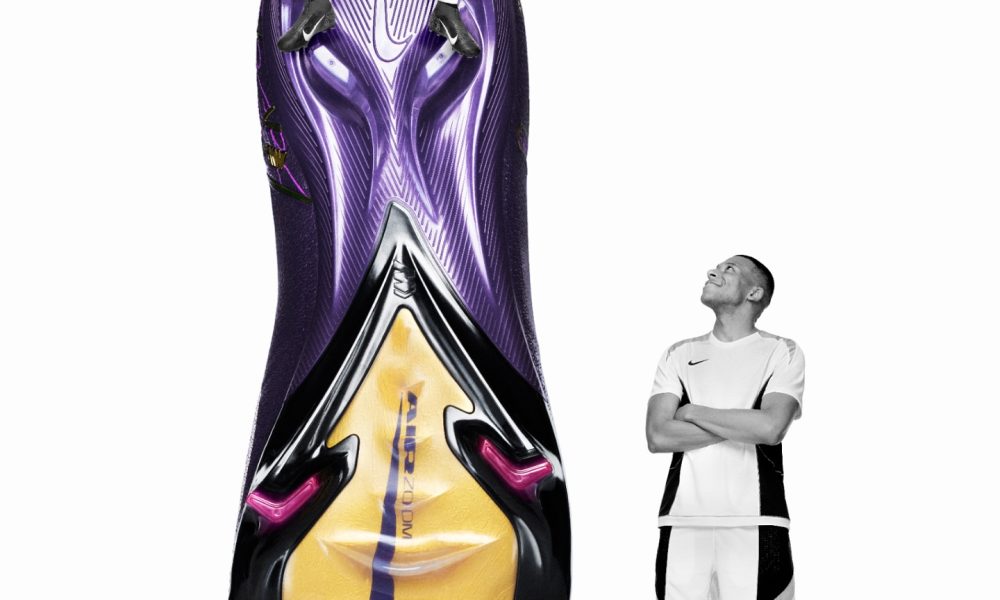Technology
Storytelling needs to inform technology in sports broadcasting not the other way around: SVG India Summit 2025

MUMBAI: Storytelling needs to inform technology in sports broadcasting not the other way around. This was one of the points made during a panel discussion at the SVG India Summit 2025.
The session was called ‘Game Changers: Understanding the Top Five Global Tech Trends’
2025 will continue to see five key technology trends influence the way sports content is produced and delivered: IP; Generative AI; the Cloud; Extended Reality and AR; and Social Media. Leaders from the U.S. and India took to the stage to debate and discuss why they are important and what they mean to anr organisation.
The Moderator was:
Ken Kerschbaumer, SVG, Co-Executive Director, Editorial
The Panellists were:
Mike Davies, Fox Sports, EVP, Technical and Field Operations; SVG U.S. Chairman
Paul Devlin, Amazon Web Services, Global Strategy Leader, Betting, Gaming & Sports Technology
Rajat Nigam, Network18 Media, Group CTO
Alessandro Reitano, Sky Deutschland, SVP, Sports Production; SVG Europe, Chairman
Nigam noted that, sports production he sees as a high-intensity reality television wherein the storytelling has to be done in an unrestricted fashion and more so impactfully and instantaneously. And that brings in the challenges and the opportunities as well. “So, the five trends, what you mentioned, everything revolves around it’s insightful, it’s immersive, it’s impactful, it’s intelligence.
“And when we are talking of since I come from Indian industry, the fifth line would be Indian, Indian-ness. Because Indian consumer is highly emotional. we need to create content which connects with the consumers.
“And that makes the softer part of the creativity comes and takes over the technology. So, that’s an important ask. And everything we do has to be multi-fold. So, pluralism is the principle. The multitude of events, the tiering, the multitude fragments of consumers, the multiple platforms.” He gave the example of needing to enhance and make the content available even in an MRI machine. While the patient is inside for 12 to 15 minutes, he should have some content to get them engaged. Similarly, FM radio, the DRM, the company uses the FM radio channel for putting in sports data while the other content continues.
“So, these are the opportunities wherein we need to look at. And with more and more data available, more and more efficient algorithms which are coming up in the name of AI, we need to apply that and convert it into content which engages.”
The moderator agreed about the soft side of production. “He’s right. Because this is the mark of a really just an intelligent way to approach it is that storytelling needs to inform technology, not the other way around. And that too often an AI is a huge problem and a solution.”
A Flexible Ecosystem: Reitano was asked about trends that make the technology better, the trends in budgets, which obviously is a constant battle of getting enough budget in order to do things the way you want to do them. And third is the consumer trends that are shaping, driving operations at Sky Deutschland. Reitano noted that it’s different from a European perspective, it’s a different landscape. “This is a very saturated market. Obviously, we have to work in a different way.
“For us, it means tech trends is how we become super-efficient. So that means at the end of the day, our key principle, if you can automate things, you have to automate. We have our key events. But after that, we have a really, really close look at what can we automate in the content processing to cater every, let’s say, audience group we have to cater. And there’s a ton of platforms. There’s not only one linear channel.
“There’s OTT, there’s TikTok, there’s Facebook, there’s everything. And I think to get the thing done, you have to build an ecosystem which is possible to, let’s say, start from your localisation on site and get multiple outputs at the same time. So – and I see this as the most trending part. Whatever sits in the ecosystem will give us the ability to produce more content to the same amount of people. I’m not talking about less, the same amount of people. But we have to increase, let’s say, the content volume. It’s very simple. We run consultation. We run a 24-news channel on sports. And we have all the outputs, let’s say, which we have to deliver. And that’s why you have a very flexible ecosystem in place. And I think this is a trend.” For him its is important to be both flexible and scalable and adaptable what’s coming up next.
The Sky Advantage: He was asked that given the other entities within Sky across Europe if that gives him more buying power to get scalability more cost-effective? His reply was absolutely. “At the end of the day, what we share, is all worth it in the entire industry.” In terms of what is next he noted that if it comes to live operation, scalability, his company is working with Sky as a Sky on a Sky group platform. “I mean, we’re producing 25,000, 30,000 hours on linear channels, but the same amount of hours on our so-called bonus streams.
“And this sits entirely in the cloud. And this is based and leveraged by, let’s say, us, Sky Italia, Sky Austria, all the group affiliates at Sky. And it’s driven by Sky UK. So, we leverage the entire platform, which helps us to produce more content, everything cloud-based, data-driven. It is, for us, really important because we’re bypassing, let’s say, our production center and deliver, let’s say, more content for our customers. And this is, at the end of the day, this is everything what counts.
Learning From The US: He admitted that he admires US broadcasting because it always starts with entertainment and then comes to sports. It’s not the other way around. “Sometimes in Europe, we’re discussing too much, very serious about sports, and forget about the entertainment sector. And if you look into the demographics, what you see in front of you, they love entertainment, by the way. And sports is not only life.
“You have to wake up with sports. You go to bed with sports. In between, there’s tons of stories to tell. And this is, I think, one of those challenges for us as storytellers and production companies and services, how to cater everything. And this is all about the scalability. Yes, whenever you can leverage as a group, you have to leverage.”
Player Tracking’s Role In Storytelling: Devlin noted that his background pre-AWS was in high-performance sport. And so a lot of that involved player track. “Definitely a trend I’ve seen over the last probably ten years in high-performance, the last five years, all over the world, is that of player tracking. Trust me, from a performance side, it’s really important athletes perform, or you get fired, or that they don’t get injured.
“But we try our best to mitigate them getting injured. So there’s an awful lot of detail that goes into the analysis of that player tracking data and its impact on performance. A sub-segment of that is incredibly, incredibly valuable for storytelling.”
He shed light on how Bundesliga match facts are created. There are three million data points per game, and that is between 16 and 22 cameras in the stadium tracking the athletes ten times per second. That tracks them physically and tells you what they did, but it doesn’t tell you why they did it.
“It doesn’t tell you why a player sprinted up the sideline. What we then do is take the match event data, passes, shots, headers, free kicks, fouls, and we sync those two data sets together. And then quite simply use machine learning to ask questions that fans want answers to.
“So if you think about that particular match insight passing profile, before machine learning and player tracking and syncing of the two data sets, a good passer of the ball was a player who completed the most passes. That might be short passes, of two, three meters, continually over the game.That doesn’t help a fan understand the game at a deeper level.
“A good insight into the objective outcomes here was that the Bundesliga did a fan survey to check are these insights landing? Because at the end of the day, they’re an experiment, they’re what we call arms on a two-way door decision. And they found that 97% of their fans found it insightful and added value to them, which is a nice number.
“But for me, a really important number was that 90% of the fans surveyed said it helped them to better understand the game. What we’re doing and what we’re putting on screen helps fans to understand. The job of a striker is to put the ball in the goal. It’s very hard to do that. You would think you’re back to goal.
“Yet the striker is most effective there. A third of the time, 34% of his passes are actually back towards his own goal, which allows the shot to go and go. Previously, that depth of analysis and therefore storytelling in the broadcast just wasn’t possible.”
He said the same holds true for tennis, the NFL, cricket. “Tracking data, contextualised to enhance the storytelling for fan engagement.”
Working Backwards From Fans: He noted that a sports organisation must focus on working backwards from fans. That doesn’t always mean you get it right. And the spirit of experimentation is critical to that.
He gave the example of the F1 app. “What questions could we answer for fans? I think Formula 1, in particular, do an incredible job of this. When you look at the Formula 1 and the amount of insights that they generate.” He said that his oldest daughter is 18 now. She watched ‘Try To Survive’ and then downloaded the F1 app and enableed notifications.
She doesn’t watch F1 but knew that due to notifications that Lando Norris was not doing well. “And she was telling me about how Lando was struggling in comparison to Kimi Antonelli. And told me all about what was going on in Formula 1. Now, she’s never actually watched the full Formula 1 race. But she’s also not in that category where everyone says, oh, they only watch highlights. She doesn’t watch highlights either. She’s just reading the notifications and she watches the documentary. So, we think about the engagement for her as a fan.
“What she wants to know is a bit of the entertainment, a bit of the gossip, a bit of what’s going on. But she’s a fan at 18 years of age. Again, there’s different ways to engage. But you have to work backwards from the fact that they do use Amazon Personalise. Which is a machine learning tool that learns what the fan wants from the notification and pushes them the content that they want. Clearly, in that case, it’s working pretty well.”
Real-time Data Analysation And Visualisation Is The Future: Reitano was asked how the technology, the speed of the ability to use these systems, impacting, just making it better storytelling? He noted that
in his case it is offering xustomers a so-called technical feed. “It’s a dedicated feed next to our primary broadcast. You can watch really from a tactical perspective. So for all the tactical freaks, you have all the data coming in. And let’s say two years ago, it took us, let’s say, a minute for the turnaround to get the data visualized.
“Now we are, let’s say, up to 20 seconds. At the end of the day, you want to have real-time data analyzation and visualisation. Then you can predict things in your own language, what you want to predict. And I think this is, at the end of the day, this is from our perspective than the future. Not only by saying, okay, fans, you have a really tactical feed, but you can predict things by your own if you play around with data. So always what if, what if the striker would, let’s say, run 10K faster? I don’t know.
“Or he would left foot instead of a right foot. Then you would have all the prediction data coming in. But you want to predict it. But therefore, you need live-life visualization. That’s the really key. And that’s the thing what we’re working on.” The key is to make sure there is live data visualised instantly. “And then you call it up from your preference what you want to tell your customers. And that is your own dedicated story because it’s more than a simple storytelling, which position should be the striker in, in the box, out of the box, left foot, right foot.
“Then you can predict things. And I think this is where we want to head in the next couple of, the next season on because we have all the live-life data. And you told us there’s 3 million data points. it’s a lot of things coming into something. And then you have to visualize it. And you have to tell a story.
“And that’s why AI comes into to help us to make it better also for the storytellers.”
Devlin noted that this is a really good point. “All of these sports have been collecting data for such a long period now. It’s creating historical archives. So, as you mentioned, stats have been collecting data for a long time now.
All of the major football codes, same in cricket. There’s a ton of data there. And therefore, we’re seeing a trend of creating graphics out of that that help engage fans like we talked about.
“I think there is an exciting opportunity in the present but also the near future to enable fans to be able to do that should they wish. So, yeah, it might not be for everybody. It might not be in a major broadcast. But the ability for fans through second screen or even post-match to be able to dive into that data and then visualise it with natural language query, I think that’s an exciting development.”
AI Can Be An Issue: Davies noted that now you’re getting a lot of solutions looking for a problem, with AI crap. But just because you can use AI doesn’t mean you should. “So, my trend is it’s the tale of two worlds. It’s the tale of the flagship at the summit, the flagship shows, your cricket, your Bundesliga, my NFL.
“And those are the ones that we’re throwing money at. We’re throwing money at because we’re trying to increase the spectacle. The spectacle, these resource hunger shows and we’re putting more and more money in it. We’re not so much on the efficiency side on that. But in the mid-tier events, that’s where you’re really going to see where can we get a similar product or very much the same product using some very, you know, innovative ways.
“Now maybe you’re talking about automation, maybe you’re talking about remote technology, maybe you’re talking about all of the things that make production more efficient. And in some ways, the mid-tier productions, if you squint, is subsidising the top tiers. So you’re following the eyes.”
Nigam agreed saying that there is a need to create different levels of production.
“So the high or for the premium events, we deploy different sort of production techniques, which would entail more number of resources, more number of expenses as well. There would be certain events, or even the lower tiering of the same event, wherein we could use technology to optimise, to bring in automation, wherein the cost of production becomes low, as well as the number of resources and the dependency goes low. So the fragmentation is the key, wherein lot and lot of opportunities are there.
“How do you stitch that together? The pie remains constant. We have to allocate that pie to bring the value very quickly.”
Lower-end technology has become very capable: One trend pointed out in terms of technology is the lower-end technology is so capable now. Viacom 18 used iPhones at the Olympics last year. There are also automated camera systems. One can do very cost-effective shows with almost little compromise in terms of the overall production value. Davies noted that sometimes today’s efficiency technology becomes tomorrow’s enhancement technology and sometimes vice versa.
“So I think that we’re not necessarily interested in putting too much remotely or putting too much on automation on the flagship shows. But what you find is that sometimes that technology can have other uses. You think about, well, can this type of technology do auto-framing on a pylon camera? Now that might be a very small thing.
“I told you a hundred cameras. Maybe it doesn’t make air. It’s just what your risk tolerance is on that particular thing. And can you actually ascribe some improvement by using those things?”
Reitano noted that the good thing is on technology, and this is very helpful because it feeds also, let’s say, the customer you can produce more content on the lower end. “And you have to consider that there are tons of content out there. They were invisible the last couple of years because it was too expensive to produce them. And now you are capable, let’s say, halving with, let’s say, one camera, automating stitching, whatsoever. And you’re producing tons of more content and feeding, let’s say, the customer’s needs. So it gives us, if you accept the compromises, I think this is sometimes very, let’s say, hard to understandable for sea level.
“Because they are measuring whatever comes on Sky platform needs to be top-notch. And now you’re starting to compromise and producing more lower tiers.” He gave an example of in Mumbai an under-17 match-up taking place. And there were a problem with encoding and decoding. nd this is how you want to educate. How you educate your customer on different platforms. Because there is and must be a compromise.
“You can’t have resiliency and reliability on 100% if you’re having a fully automated camera system, which is cloud and IP only. So you have to find a compromise. But this is an education curve.
“You’re offering more content for your customers. On the same side, you’re lowering your production cost, which is part of your ecosystem. And then you have to find, let’s say, a good conversation with your customer base because they’re not paying more for that.
“This is absolutely a deal. We’re offering incremental services free of charge. But this is happening because customers are reacting. (24:12) They don’t care what they see. At the moment, if the Sky-corner bug is up, they’re expecting premium quality.”
Nigam was asked about 9×16 productions where one is actually using automated camera. Noigam said that those are the opportunities. “Yes, we do that. And I would pick the line that you mentioned earlier. You used an adjective along with artificial intelligence. So somehow that remains an elephant and somehow all of us tend to get obsessed by that.
“Fortunately or unfortunately, this has been there. AI is nothing but automation. And this has been there or various levels of automation has been there for many, many years. And all of us deploy those automations with respect to the live productions that we do.
“What the consumer requires is a plain, simple, good storytelling about that particular event. Like for cricket, the live event happens with seven cameras. The story gets completed in seven cameras wherein we tend to use more than 30 cameras. Now, how well the additional 25 or 30 cameras have to be used, that’s an option.
“The story gets completed in those seven cameras. And again, at the end of the day, the consumer is not bothered what is that being used at the back end. What it means is, for example, I would pick in this IPL, we have been doing a lot of different things. Each IPL match is getting produced in 25 different streams, getting distributed in more than 70 different ways, etc., etc. (26:08) But what it has caught the eye of the consumer is one physical feature which we call it as Champak. So, Champak, which is not an artificial intelligence thing.
“It’s a physical, physical technology product which has caught the eye of the consumer. So, that’s something innovation we need to bring in.
Just because we want to deploy artificial intelligence, that does not mean everything will get enhanced. We need to capture the spirit of the consumer, certainly keep them excited, keep them engaged. But then, there are ways to do it.”
Technology
Retro Cartoon Tech Accessories : Higround x SEGA

The ‘Summit 65+,’ presented in a Dreamcast-inspired design, features a CNC aluminum case, stainless steel back plate, and Higround’s ‘Dampening Plus’ five-layer system for a stable, quiet typing experience. The ‘Basecamp 65HE,’ influenced by the Radical Highway level, debuts Hall Effect technology for increased precision. Additional offerings—including the Classic Sonic–themed ‘Basecamp 96+,’ two ‘Basecamp 75+’ versions inspired by Escape from the City and Sonic CD, a Sonic CD keycap set, and four coordinated XL mousepads—further unify the collection’s nostalgic yet contemporary character.
Image Credit: Higround
Technology
How Miami’s Sports Culture Reflects the High-Energy Mindset Driving Today’s Tech Innovations – Five Reasons Sports Network

The Competitive Spirit That Powers Both Sports and Startups
Miami sports fans know that greatness comes from more than talent alone. Whether it’s the Heat grinding through a tight fourth quarter or the Dolphins executing a perfectly timed offensive scheme, winning requires discipline, fast thinking, and an unshakeable competitive spirit. Interestingly, these same qualities power the tech and startup world, where entrepreneurs make split-second decisions that can define the future of an entire business.
In both arenas, success belongs to those who can read momentum, adapt under pressure, and turn small opportunities into game-changing wins. That overlap is why so many sports-minded individuals naturally thrive in the world of business, innovation, and technology.
Why Analytics in Sports Fuel Smarter Business Thinking
Today’s sports landscape is driven by analytics—shot charts, win probability graphs, EPA metrics, and possession efficiency numbers are all part of modern fan knowledge. This analytical mindset doesn’t stop at the arena. Tech entrepreneurs, founders, and investors rely on the same data-driven thinking to navigate product decisions, market shifts, and competition.
This crossover is why the startup world attracts problem solvers shaped by sports culture. And platforms in the entertainment-tech space—such as Foxy gold casino—reflect this growing connection between digital innovation, predictive thinking, and user engagement.
Understanding Momentum: A Shared Advantage for Founders and Athletes
Momentum is everything. In sports, a single run, turnover, or three-pointer can change the energy in seconds. In business, momentum might be a viral post, a successful beta launch, or hitting a major funding milestone. Leaders in both fields understand how to recognize momentum and capitalize on it.
This parallels perfectly:
- Athletes ride hot streaks.
- Founders capitalize on traction.
- Sports teams adjust mid-play.
- Startups pivot product strategy just as quickly.
The ability to shift gears on the fly is one of the most important skills in sports and tech alike.
Building a Winning Strategy: What Startups Can Learn From Miami Sports
1. Scouting and Research Matter
Sports teams invest heavily in scouting reports and film studies. They evaluate:
- Opponent strengths
- Player tendencies
- Lineup matchups
- Efficiency ratings
Startups mirror this with market research, user interviews, competitive analysis, and data modeling. Knowing the landscape allows founders to execute smarter, faster, and with more confidence.
2. Team Culture Determines Long-Term Success
The Miami Heat built the “Heat Culture,” known for discipline, conditioning, and accountability. Startups adopting similar cultural principles see major benefits:
- Clear leadership and communication
- Defined expectations
- Continuous improvement
- Resilience under pressure
A strong culture is often the difference between a startup that scales—and one that collapses.
3. Adaptability Separates Winners From the Rest
Sports demand constant adjustments: defensive rotations, halftime strategies, and clutch-time decisions. Startups face equally rapid shifts:
- Market changes
- New competitors
- Shifting user demand
- Technological breakthroughs
Founders who adapt quickly, without losing their vision, stay competitive.
Table: Business Lessons Inspired by Miami’s Sports Playbook
| Miami Sports Principle | Startup Application | Tech/Innovation Impact |
| Heat Culture | Strong internal systems | Higher productivity & retention |
| Film study & analytics | Market and user research | Better decision-making |
| In-game adjustments | Product pivots | Faster adaptation to trends |
| Team chemistry | Cross-functional collaboration | Smoother product scaling |
| Game-winning mentality | Resilient leadership | Strong long-term growth |
How Miami’s Fast-Paced Environment Fuels Innovation
South Florida’s sports scene is known for energy, excitement, and bold plays. Coincidentally, Miami’s startup scene mirrors that same intensity. The city has quickly become a hub for fintech, AI, gaming, and digital entertainment. Entrepreneurs here are used to speed—speed of execution, iteration, and scaling.
A few reasons Miami is thriving in the innovation sector:
- Diverse global talent
- High investor interest
- Strong tech community backing
- Growing digital entertainment market
- Crossover influence from sports and media
Miami is one of the few cities where sports culture and startup culture genuinely feed each other.
Technology Is Changing the Game—On the Field and in the Office
Technology has reshaped sports with player-tracking systems, real-time analytics, and dynamic stat models. Meanwhile, tech startups use automation, AI-driven insights, and SaaS platforms to accelerate growth. Both industries depend on innovation to stay ahead.
Today’s fans and founders alike have access to tools such as:
- Predictive analytics
- Machine learning insights
- Automated reporting dashboards
- Real-time performance tracking
- Competitive intelligence platforms
This shared tech ecosystem keeps both sports teams and startups laser-focused on performance.
The Role of Mindset: What Makes Sports Fans Natural Innovators
Sports fans understand pressure. They analyze plays, debate strategies, track performance trends, and anticipate outcomes. These instincts make them naturally suited for entrepreneurship and tech leadership.
Key mindset overlaps include:
- Confidence under pressure
- Long-term thinking
- Understanding risk and reward
- Embracing competition
- Continuous improvement
Sports create thinkers who thrive in fast-paced, unpredictable environments—the exact conditions startups face daily.
Why the Connection Between Sports and Startups Keeps Growing
Sports influence is everywhere—from data modeling to team culture to leadership strategy. At the same time, tech continues to elevate sports through analytics, digital enhancements, and real-time engagement tools. The crossover strengthens every year, especially in vibrant markets like Miami.
As both industries push forward, one thing remains true: the mindset that wins games is the same mindset that builds the next big company. Athletes, analysts, fans, and founders all share a core advantage—a competitive drive, sharpened by strategy, that fuels consistent growth.
Technology
Lakeview Academy unveils renovated Innovation and Technology Wing

Lakeview Academy in Gainesville recently unveiled its newly renovated Innovation and Technology Wing.
The learning environment is designed to inspire creativity, collaboration, and hands-on problem-solving.
“The expanded robotics and esports facilities give our students room to imagine bigger and build bolder,” Technology Director Mikhail Lovell, said. “With advanced tools like industrial laser cutters and high-performance 3D printers, they can design and create with a level of precision and freedom that we couldn’t offer before. This renovation strengthens the programs our students already love while opening the door to new opportunities for innovation, growth, and achievement.”
School officials said the renovation was made possible through Lakeview donors and community partners who share in the school’s mission to cultivate curiosity, excellence, and forward-thinking leadership.
“This renovation represents more than just new facilities,” John Simpson, Head of School at Lakeview Academy, said. “It is an investment in our students’ future and a reflection of Lakeview’s vision to provide a learning environment that mirrors the innovation and collaboration found in today’s leading industries.”
Technology
All Winners List for The Game Awards 2025 Revealed

The Game Awards 2025 concluded on December 11 in Los Angeles, celebrating a standout year in gaming. The ceremony unveiled the full All Winners List across major categories, including Game of the Year, Best Art Direction, Best Narrative, and more. Fans tuned in worldwide to see whether Clair Obscur Expedition 33, Death Stranding 2 On the Beach, or Donkey Kong Bananza would claim top honors.
This year delivered an unusually competitive field. Nearly every major genre saw multiple critically acclaimed releases. The All Winners List highlights how diverse the gaming landscape has become, rewarding innovation, storytelling, performance, and design. Below is the complete breakdown of winners as confirmed during the live show.
Full All Winners List for The Game Awards 2025
The Game Awards recognized excellence across more than 30 categories. The All Winners List below reflects the official results announced during the broadcast. These selections were made through a combination of jury voting and fan participation. Trusted outlets such as Reuters and AP covered the event throughout the week, citing its global impact on the entertainment industry.
The ceremony featured wins for established franchises, emerging studios, and standout indie titles. Clair Obscur Expedition 33 dominated several major categories, cementing its status as one of the year’s most influential releases. Death Stranding 2 On the Beach and Hollow Knight Silksong also secured notable wins across art, music, and direction.


The winners list includes categories such as:
- Game of the Year
- Player’s Voice
- Best Game Direction
- Best Adaptation
- Best Narrative
- Best Art Direction
- Best Score and Music
- Best Audio Design
- Best Performance
- Innovation in Accessibility
- Games for Impact
- Best Ongoing Game
- Best Community Support
- Best Independent Game
- Best Debut Indie Game
- Best Mobile Game
- Best VR/AR Game
- Best Action Game
- Best Action/Adventure Game
- Best RPG
- Best Fighting Game
- Best Family Game
- Best Sim/Strategy Game
- Best Sports/Racing Game
- Best Multiplayer Game
- Most Anticipated Game
- Content Creator of the Year
- Best Esports Game
- Best Esports Athlete
- Best Esports Team
Each winner reflects the shifting trends of interactive entertainment. Publishers invested heavily in cinematic storytelling, AI-driven mechanics, and world-building. Indie studios saw renewed recognition, demonstrating how smaller teams continue to push creative boundaries.
How the 2025 All Winners List Shapes the Industry
The impact of the All Winners List extends far beyond the ceremony. Industry analysts note that Game Awards recognition often boosts sales, renews franchise momentum, and influences publisher strategies for the following year. Reuters reported that award-winning titles typically experience a significant rise in global downloads after the show’s conclusion.
For indie creators, nominations and wins can accelerate distribution partnerships and platform support. For major studios, standout wins in categories such as Game Direction or Narrative reinforce creative leadership and help guide long-term development pipelines.
The All Winners List also redirects attention toward emerging technologies showcased in nominated titles. VR advancements, accessibility innovations, and audio engineering breakthroughs from this year’s winners are expected to shape next-generation game design approaches.
The Game Awards 2025 All Winners List underscores how far the medium has evolved. It highlights a year defined by risk-taking, creativity, and boundary-pushing design. Fans now look ahead to 2026 as studios aim to build on the momentum created by this remarkable lineup of winners.
FYI (keeping you in the loop)-
Q1: What is included in The Game Awards 2025 All Winners List?
The list includes winners across more than 30 categories, covering major genres and industry achievements. Categories range from Game of the Year to Best Esports Team.
Q2: Which game won the most awards in 2025?
Clair Obscur Expedition 33 earned multiple major category wins, reflecting strong critical and fan support.
Q3: Why is The Game Awards All Winners List important?
The list influences sales trends, industry recognition, and future project investment decisions. It sets expectations for upcoming releases.
Q4: How are winners selected for The Game Awards?
A combined jury and public voting system determines winners. Both professional critics and global players contribute.
Q5: Does winning an award impact game development studios?
Recognition often leads to increased funding, hiring, and platform visibility. It can also validate creative direction for future titles.
iNews covers the latest and most impactful stories across
entertainment,
business,
sports,
politics, and
technology,
from AI breakthroughs to major global developments. Stay updated with the trends shaping our world. For news tips, editorial feedback, or professional inquiries, please email us at
[email protected].
Get the latest news and Breaking News first by following us on
Google News,
Twitter,
Facebook,
Telegram
, and subscribe to our
YouTube channel.
Technology
Gaming PC Market to Expand at 7.29% CAGR Through 2035 Driven


Gaming PC Market is witnessing rapid expansion as gaming evolves into one of the largest and most impactful segments of the digital entertainment industry. According to Market Research Future (MRFR), the Gaming PC Market Size was valued at USD 46.98 billion in 2024. The Gaming PC industry is projected to grow from USD 50.41 billion in 2025 to USD 101.9 billion by 2035, exhibiting a strong and consistent compound annual growth rate (CAGR) of 7.29% during the forecast period from 2025 to 2035.
The rise of high-performance gaming hardware, increasing popularity of competitive gaming, and strong global demand for immersive entertainment experiences are major factors supporting market growth. Gaming PCs are now central to professional eSports, casual gaming, and content creation, making the industry a key driver of technological innovation.
Market Drivers Fueling the Growth of the Gaming PC Market
One of the primary drivers accelerating the Gaming PC Market is the explosive rise of the global eSports ecosystem. Millions of players participate in online competitions, and large-scale tournaments attract global audiences. Professional gamers demand high-performance PCs capable of delivering maximum responsiveness, minimal lag, and high frame rates, directly boosting the need for advanced gaming systems.
Another critical driver is rapid GPU and CPU innovation. Leading hardware manufacturers continue to develop powerful processors and graphics cards equipped with next-generation capabilities such as ray tracing, AI-enhanced rendering, and ultra-fast clock speeds. These innovations significantly elevate gaming experiences and motivate both casual gamers and professionals to upgrade their systems.
The increasing popularity of open-world, high-resolution, and graphically demanding games is further boosting Gaming PC adoption. Modern titles require advanced hardware to support realistic visuals and immersive gameplay, pushing consumers toward high-end gaming PCs.
The rise of game streaming and content creation is also contributing to market expansion. Platforms such as Twitch, YouTube Gaming, and Facebook Gaming are encouraging gamers to produce high-quality content. This requires powerful systems that support streaming, recording, editing, and gameplay simultaneously.
Customization and personalization trends are shaping consumer behavior as well. Gamers increasingly prefer custom-built PCs with RGB lighting, advanced cooling solutions, and modular components. This trend is creating new opportunities for manufacturers, retailers, and PC assembly services globally.
Get An Exclusive Sample of the Research Report at – https://www.marketresearchfuture.com/sample_request/26477
Key Market Trends Shaping the Gaming PC Market
The Gaming PC Market is being reshaped by a number of powerful trends. One of the most significant is the integration of artificial intelligence into gaming hardware. AI-driven optimization tools help maximize performance, regulate cooling, enhance frame rates, and adjust settings in real time.
Another major trend is the growing dominance of high-performance gaming laptops. With advancements in thermal engineering and GPU performance, gaming laptops now offer nearly desktop-level power. This trend supports gamers who value flexibility and portability without sacrificing performance.
High-refresh-rate monitors are becoming standard among gamers. Demand for 144Hz, 240Hz, and even 360Hz displays is rising as gamers seek smoother animation and higher responsiveness, driving the need for PCs capable of supporting these advanced displays.
Liquid cooling systems are also gaining popularity. As gaming hardware becomes more powerful, maintaining safe temperatures is essential. Gamers increasingly adopt closed-loop and custom-loop liquid cooling systems to ensure long-term stability and performance.
Sustainable and energy-efficient gaming solutions are emerging as a new trend. Manufacturers are focusing on recyclable components, environmentally friendly production processes, and energy-efficient power supplies. This aligns with global sustainability awareness and appeals to environmentally conscious gamers.
Buy Now Immediate Delivery Available at – https://www.marketresearchfuture.com/checkout?currency=one_user-USD&report_id=26477
Regional Analysis of the Gaming PC Market
North America currently dominates the Gaming PC Market, supported by a large base of professional gamers, robust digital infrastructure, and widespread adoption of high-performance gaming systems. The United States remains a global leader in gaming hardware development and eSports investment.
Europe holds a significant share of the market as well. Countries such as Germany, France, and the United Kingdom have strong gaming cultures, extensive PC gaming communities, and widespread interest in competitive gaming. Government recognition of eSports as an official sport in certain regions has further strengthened market demand.
The Asia-Pacific region is poised for the highest growth rate during the forecast period. Nations such as China, South Korea, Japan, and India are expanding rapidly in the gaming ecosystem. China leads the region with millions of active gamers and strong investment in gaming arenas, esports stadiums, and internet cafés. South Korea remains a global pioneer in professional gaming and eSports.
Latin America is also witnessing rising Gaming PC adoption. Countries such as Brazil, Mexico, and Argentina are experiencing increasing interest in professional gaming and streaming, supported by improved internet connectivity and the establishment of local gaming events.
In the Middle East and Africa, gaming is expanding as younger populations adopt digital entertainment. Countries such as the UAE and Saudi Arabia are investing heavily in eSports infrastructure, creating new opportunities for Gaming PC manufacturers.
Challenges and Constraints in the Gaming PC Market
Despite strong growth potential, the Gaming PC Market faces several challenges. One major constraint is the high cost of components such as GPUs, CPUs, and high-performance RAM. Price fluctuations and supply shortages often discourage consumers from purchasing or upgrading gaming PCs.
Another challenge is the global supply chain volatility that affects semiconductor manufacturing. Limited chip availability during periods of high demand can delay product releases and reduce availability in key markets.
Energy consumption and heat generation are significant constraints as well. High-performance systems require efficient cooling solutions, and inadequate thermal management can impact performance and hardware longevity.
The rapid pace of technological change can also be a barrier for consumers. Frequent hardware upgrades may be required to support the latest games, making ownership costly for budget-conscious gamers.
Cybersecurity concerns surrounding online gaming and digital downloads pose additional challenges. Gamers are at risk of malware attacks, hacking, and data breaches, making security software an essential component of gaming setups.
Opportunities Driving Future Growth of the Gaming PC Market
Despite challenges, the Gaming PC Market offers vast opportunities. The expansion of VR and AR gaming is creating strong demand for powerful gaming PCs capable of supporting immersive experiences. As VR titles grow more sophisticated, hardware requirements will increase, benefiting the Gaming PC industry.
Cloud-connected gaming PCs present another major opportunity. Hybrid gaming systems that combine traditional hardware with cloud-based rendering can enhance performance and enable cost-effective upgrades.
The rise of gaming-focused social platforms is opening opportunities for PC manufacturers and accessories companies. Integrated ecosystems that support gaming, streaming, editing, and social interaction are becoming increasingly popular.
Emerging markets present strong potential for future expansion. Countries in Southeast Asia, the Middle East, Eastern Europe, and Africa are witnessing fast-growing gaming communities and rising disposable incomes, driving demand for affordable gaming PCs.
The growing support for STEM education and gaming-related careers such as game development, animation, and broadcasting is also fueling market demand. Students and professionals require powerful machines that deliver both gaming and productivity performance.
Explore the In-Depth Report Overview – https://www.marketresearchfuture.com/reports/gaming-pc-market-26477
The Gaming PC Market is set for robust expansion as global demand for high-performance gaming systems continues to rise. With a projected CAGR of 7.29% through 2035, the industry will benefit from technological innovation, eSports growth, immersive gaming trends, and rising participation in global gaming communities. Gaming PCs are becoming more advanced, more customizable, and more accessible, making them essential tools for gamers, streamers, content creators, and digital professionals alike. As hardware manufacturers push boundaries and gaming culture expands worldwide, the Gaming PC Market will remain a powerful driver of digital entertainment and global technological development.
About Market Research Future:
At Market Research Future (MRFR), we enable our customers to unravel the complexity of various industries through our Cooked Research Report (CRR), Half-Cooked Research Reports (HCRR), Raw Research Reports (3R), Continuous-Feed Research (CFR), and Market Research & Consulting Services.
MRFR team have supreme objective to provide the optimum quality market research and intelligence services to our clients. Our market research studies by products, services, technologies, applications, end users, and market players for global, regional, and country level market segments, enable our clients to see more, know more, and do more, which help to answer all their most important questions.
Contact Us:
Market Research Future (Part of Wantstats Research and Media Private Limited)
99 Hudson Street, 5Th Floor
New York, NY 10013
United States of America
+1 628 258 0071 (US)
+44 2035 002 764 (UK)
Email: sales@marketresearchfuture.com
Website: https://www.marketresearchfuture.com
This release was published on openPR.
Technology
Revived Retro Handheld Games : Ayaneo Pocket Play

A mobile-class processor powers the unit and includes 16 GB of RAM and up to 1 TB of internal storage. A dual-fan assembly and heat pipe design provide cooling. Battery capacity supports several hours of sustained gameplay, depending on the title and settings. Wireless connectivity includes Wi-Fi 6 and Bluetooth 5.2.
Image Credit: AYANEO
-

 Rec Sports3 weeks ago
Rec Sports3 weeks agoFargo girl, 13, dies after collapsing during school basketball game – Grand Forks Herald
-

 Motorsports3 weeks ago
Motorsports3 weeks agoCPG Brands Like Allegra Are Betting on F1 for the First Time
-

 Sports3 weeks ago
Sports3 weeks agoTwo Pro Volleyball Leagues Serve Up Plans for Minnesota Teams
-

 Sports3 weeks ago
Sports3 weeks agoUtah State Announces 2025-26 Indoor Track & Field Schedule
-

 Sports3 weeks ago
Sports3 weeks agoSycamores unveil 2026 track and field schedule
-

 Motorsports2 weeks ago
Motorsports2 weeks agoJo Shimoda Undergoes Back Surgery
-

 Motorsports2 weeks ago
Motorsports2 weeks agoRedemption Means First Pro Stock World Championship for Dallas Glenn
-

 Sports3 weeks ago
Sports3 weeks agoTexas volleyball vs Kentucky game score: Live SEC tournament updates
-

 Rec Sports2 weeks ago
Rec Sports2 weeks agoRobert “Bobby” Lewis Hardin, 56
-

 Rec Sports2 weeks ago
Rec Sports2 weeks agoHow this startup (and a KC sports icon) turned young players into card-carrying legends overnight


























